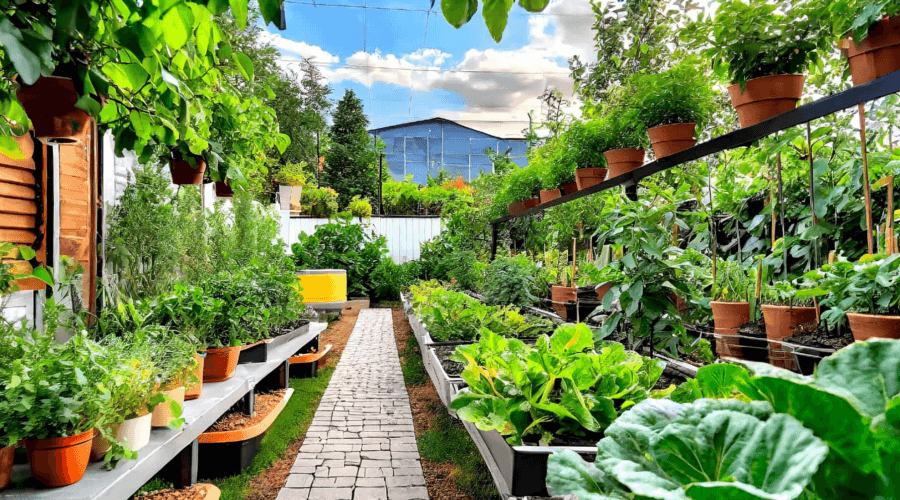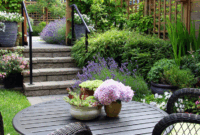Imagine walking into your backyard in 2025 to find your plants watered, soil nutrients balanced, and lighting adjusted—all without you lifting a finger. Thanks to the rise of automated garden technologies, this isn’t science fiction anymore. With the latest innovations in smart garden systems and IoT-powered devices, anyone can build a self-sustaining green space that practically takes care of itself.
Whether you’re a city dweller managing a small balcony setup or a homeowner running a full backyard garden, garden automation helps save time, conserve water, and improve plant health. In this guide, we’ll explore everything you need to know about building your own fully automated smart garden in 2025—from smart sensors and irrigation systems to energy-efficient lighting and AI-powered plant management tools.
1. Understanding What a Smart Garden Really Is
A smart garden system combines technology, sensors, and automation to manage plant care without constant human supervision. These systems monitor soil moisture, light, temperature, and humidity levels in real time. Once data is collected, the garden’s connected devices—such as sprinklers, fans, or grow lights—automatically adjust to maintain optimal growing conditions.
Leading brands like Gardena and Click & Grow offer ready-to-use automated garden kits that use AI algorithms to learn your plants’ needs. They analyze environmental changes and recommend adjustments, allowing you to enjoy healthy, thriving plants year-round.
Unlike traditional gardening, which relies on manual observation, these systems let you manage your garden remotely through smartphone apps. You can check moisture levels, control lighting, and even fertilize your plants from anywhere in the world.
Pro Tip: For beginners, start small with a compact smart planter or hydroponic setup before scaling to a fully connected outdoor garden.
2. Smart Sensors: The Heart of Garden Automation
At the core of any garden automation setup are smart sensors that collect data and send it to your control system. These sensors measure key factors like soil moisture, pH levels, temperature, and sunlight exposure. The data helps optimize growth while preventing overwatering or nutrient imbalances.
Some advanced sensor systems, like Xiaomi’s Mi Flora Sensor or Parrot Flower Power, sync directly with mobile apps and provide actionable feedback. For example, if your soil becomes too dry, your system automatically triggers the irrigation process.
Smart sensors also integrate with home automation platforms like Google Home and Apple HomeKit, allowing you to monitor your garden alongside your other connected devices. This creates a unified environment where your home and garden operate seamlessly together.
Pro Tip: Choose waterproof and solar-powered sensors for outdoor use to reduce maintenance and improve reliability.
3. Automated Irrigation Systems: Precision Watering Made Easy
Water management is one of the most crucial elements of an automated garden. Smart irrigation systems take the guesswork out of watering by adjusting schedules based on soil data and weather conditions. They prevent water waste and ensure your plants receive the exact amount of hydration they need.
Devices like Rain Bird and Orbit B-hyve offer programmable sprinkler systems that respond to real-time data from moisture sensors. You can set schedules manually or allow the system to decide when and how much to water.
For smaller spaces, micro-drip irrigation kits work wonders. These systems use tiny emitters to distribute water evenly, minimizing evaporation and promoting efficient water use. With the integration of smart controllers, they’re ideal for both indoor and outdoor gardens.
Pro Tip: Connect your irrigation system to IFTTT (If This Then That) to automate watering based on local weather forecasts—no rain, no watering!
4. Smart Lighting and Climate Control for Optimal Growth
Lighting plays a vital role in plant growth, especially in indoor or shaded gardens. Modern smart garden systems use automated LED grow lights that mimic the sun’s spectrum and adapt to each plant’s lifecycle. These lights automatically turn on or off based on daylight availability and plant requirements.
Top brands like Philips Hue and LIFX now offer energy-efficient smart grow lights that integrate with voice assistants and mobile apps. You can adjust brightness and color temperature remotely for precise control over your garden’s ecosystem.
Temperature and humidity regulation are also part of modern garden automation. Smart thermostats and dehumidifiers, such as those from Google Nest, help create stable conditions for sensitive plants like orchids and herbs.
Pro Tip: Install a smart ventilation fan to regulate airflow in enclosed garden setups, preventing mold and promoting healthy plant respiration.
5. Smart Fertilization and Nutrient Management
Proper nutrition is essential for a thriving garden. In a smart garden system, automated fertilization devices ensure plants get the right nutrients at the right time. These systems distribute liquid or soluble fertilizers based on soil data, growth cycles, and plant type.
Advanced systems like Click & Grow Smart Gardens come with preloaded nutrient pods that release nutrients automatically, eliminating the need for manual feeding. Hydroponic systems from AeroGarden use nutrient solutions managed through digital controllers for precision growth.
Many gardeners also pair these systems with mobile apps that provide feedback on plant health. This allows you to track growth data and receive notifications if your plants need adjustments.
Pro Tip: Combine nutrient automation with soil testing kits from SoilKit for a complete plant care ecosystem.
6. Integrating Smart Garden Systems with AI and IoT
In 2025, AI and the Internet of Things (IoT) are the driving forces behind the most advanced automated garden setups. These systems not only react to conditions but also learn from patterns to improve efficiency over time. AI analyzes historical weather data, plant growth rates, and sensor feedback to predict future needs.
Platforms like Amazon AWS IoT and Microsoft Azure IoT support integrated automation across devices, enabling remote management through smart home ecosystems. For example, if a heatwave is predicted, your system can increase watering cycles and adjust lighting schedules automatically.
Additionally, voice control through assistants like Google Assistant or Amazon Alexa allows hands-free management of your garden automation system.
Pro Tip: Consider investing in an open-source control hub like Home Assistant for full customization and local control without cloud dependence.
7. Sustainable Energy Solutions for Smart Gardens
One of the best aspects of an automated garden in 2025 is its ability to operate sustainably. Solar-powered devices and renewable energy solutions reduce environmental impact while cutting long-term costs. Solar panels can power irrigation systems, lighting, and sensors without relying on grid electricity.
Water recycling systems are also gaining popularity. They capture rainwater and repurpose it for irrigation, conserving water and promoting eco-friendly practices. Some advanced setups even integrate composting systems that convert organic waste into natural fertilizer.
For eco-conscious gardeners, sustainability is not just a choice—it’s a necessity. Integrating green technologies ensures your garden supports both biodiversity and climate-friendly living.
Pro Tip: Pair solar irrigation systems with Tesla Powerwall for off-grid energy storage and 24/7 reliability.
8. Best Smart Garden Kits and Tools for 2025
Building your own smart garden system doesn’t have to be complicated. Here are some of the best kits and devices for 2025:
- Click & Grow Smart Garden 27 – A sleek, indoor hydroponic system ideal for herbs and vegetables.
- Gardena Smart System – Offers modular automation for watering, lighting, and sensor integration.
- AeroGarden Bounty Elite – A countertop garden with voice-controlled automation and Wi-Fi connectivity.
- Rain Bird Smart Irrigation – Perfect for large outdoor landscapes and precision watering.
- Home Assistant Automation Hub – Great for customizing cross-platform smart garden automation.
Each of these kits can be combined to create a fully interconnected garden automation ecosystem. The choice depends on your space, budget, and technical comfort level.
Final Thoughts: The Future of Gardening Is Smarter Than Ever
The future of gardening is intelligent, efficient, and sustainable. By 2025, a smart garden system can do much more than just water your plants—it can monitor their health, predict weather changes, and optimize growth patterns automatically. Whether you’re growing vegetables, herbs, or ornamental plants, embracing garden automation will save you time and effort while delivering professional-level results.
In short, an automated garden isn’t just a convenience; it’s the future of responsible and rewarding gardening. Ready to get started? Explore our internal guide on Sustainable Homes: The Future of Eco-Friendly Living and AI Tools for Entrepreneurs for more ways technology can enhance your lifestyle.




